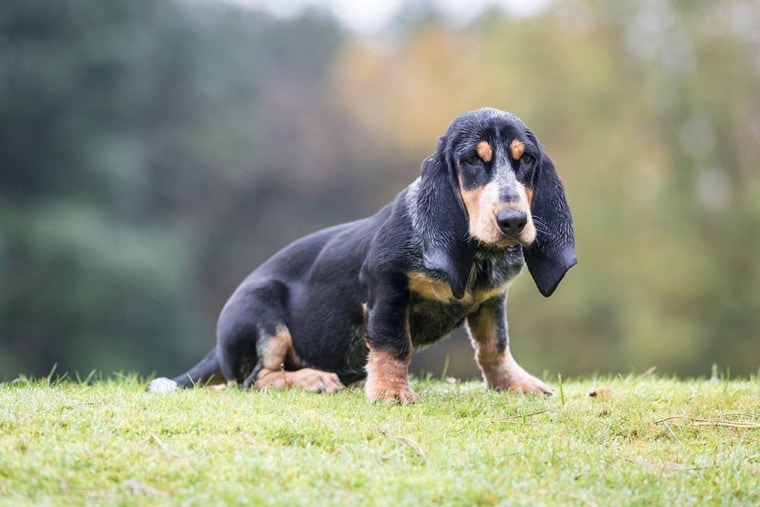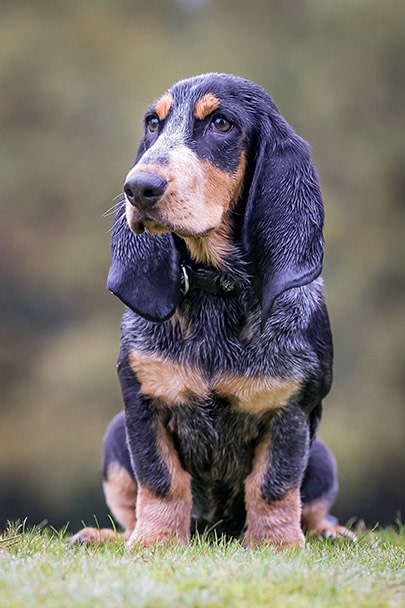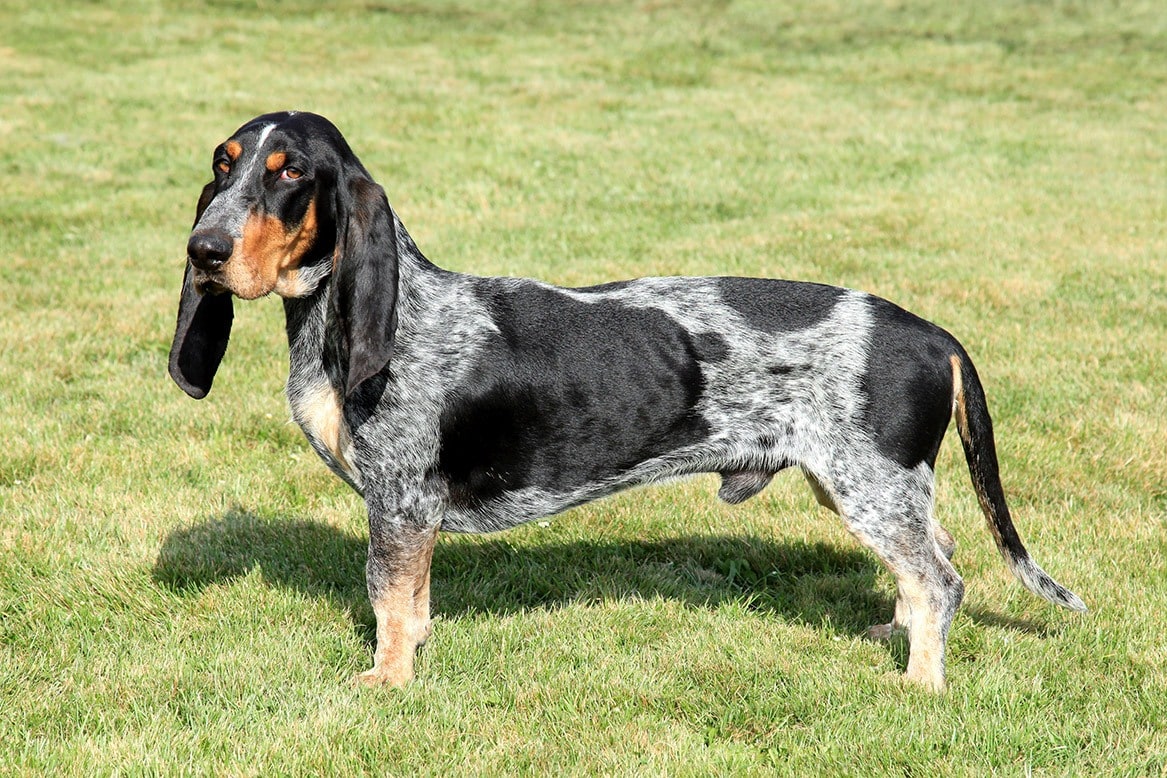
Click Below to Skip Ahead
The Basset Bleu De Gascogne is a rare dog that originated in France. This canine looks a bit like a Basset Hound, but with a completely different coloration. They are an older breed and likely were first bred during the Middle Ages. Despite their longevity, this breed almost fell out of existence in the 19th century. They were saved, barely, and are still quite rare today.
Breed Overview
Height:
13 – 15 inches
Weight:
35 – 40 pounds
Lifespan:
10+ years
Colors:
Mottled white and black (“blue”)
Suitable for:
Laidback families
Temperament:
Eager to please, friendly, playful
It is odd to find this canine outside of their homeland of France. Some are in the U.K., likely due to the geographical proximity of the two countries. They are almost unheard of in the United States and must usually be imported. They aren’t a recognized breed in the American Kennel Club (AKC).
This dog is most well-known for their almost completed ticked body. They are white with small black dots. They look similar to cookies-and-cream ice cream. Besides this, they are a typical hound in appearance and personality.
Basset Bleu De Gascogne Characteristics
Basset Bleu De Gascogne Puppies
The primary issue with adopting a Basset Bleu De Gascogne puppy is finding one. They are extremely rare and practically impossible to find in the United States. Because records are not kept by the AKC on this breed, you can’t head to the breeder’s database to help with your search. As of this writing, we were unable to find any puppies currently available. Therefore, your only option might be to import a dog from France. Because this is a long flight, you’ll likely have to wait for the puppy to get a bit older. Be sure to factor this into the cost of the puppy. You may be able to find puppies located in the U.K., but this is rarer.
When you find a Basset Bleu De Gascogne, you’ll be bringing home a calm and loyal dog. They tend to have a laid-back attitude and make amazing pets for inactive families.
Temperament & Intelligence of the Basset Bleu De Gascogne
If you’ve ever met a hound, you probably have a good idea of what this dog acts like. This canine is exceedingly friendly with just about everyone. They are not hyperactive in their greetings like other dogs, though. Instead, they tend to be rather laidback and calm.
They are relatively easy to please, which makes them much more trainable than most hounds out there. They can also be a bit playful when they are younger. However, this playfulness often diminishes as they get older. Adult Basset Bleu De Gascogne does a great deal of laying around, unless they’re out hunting.
Surprisingly, these dogs have quite a bit of stamina. They can trot for seemingly forever. Despite this, they are not hyperactive and do not have high exercise needs. They are well-behaved indoors and rarely jump.
Because the Basset Bleu De Gascogne is a scent hound, they should be kept in a fenced-in area or on a leash when outside. They will follow just about any trail that they can find, which often leads to them getting lost. When hunting, they don’t pay attention to anything else, so they don’t know how to get back.
While not exceedingly intelligent, this canine does get bored easily. For this reason, they should not be left alone for long periods. Puzzle toys are ideal, though some of these dogs aren’t food-driven enough to play with them. Training and walks are great for keeping them entertained, especially if you let them sniff around.
As you would expect from a hound, this dog has a loud voice. For this reason, we do not recommend them for apartments. They can bay loudly and tend to be quite vocal.

Are These Dogs Good for Families? 👪
The Basset Bleu De Gascogne does well around children as long as you socialize them correctly. These dogs need to be around children from a young age to learn how to put up with their antics. If introduced early, they can be great playmates when the children are younger and laidback companions when they are older.
Does This Breed Get Along With Other Pets?
This breed does perfectly fine around dogs of all sorts. They like to play, as well as laze around all day, so you can pair them with practically any other breed. Your only concern should be larger dogs jumping on their backs, as this can cause injury.
They can do okay with cats and similar pets. However, they do have strong hunting instincts that may cause them to chase cats. Early socialization can be helpful here, especially if you can find confident cats that aren’t interested in running from a dog.
Things to Know When Owning a Basset Bleu De Gascogne
Food & Diet Requirements 🦴
These dogs do not have any specific dietary requirements beyond any other dog, but they work best with high-quality dog food. Look for formulas that are high in meat and protein. Avoid those that use tons of grains or veggies, including peas and potatoes. These fillers may have some nutritional value when used in small amounts, but a company can stuff a food full of them, as they are cheap ingredients.
These dogs are prone to obesity, so it is essential to watch their weight. Even a bit of extra weight can cause problems for these smaller dogs. Often, obesity is tied to a lack of exercise, not necessarily their diet. Still, their diet will often need to be adjusted as well.
Exercise 🐕
The Basset Bleu De Gascogne does not require extensive exercise. They are laidback dogs. A single short to moderate walk a day is all that they need to stay happy and healthy. Outdoor playtime in a fenced-in backyard is typically a good option too.
When left to their own devices, these canines often become couch potatoes. For this reason, it is essential that you encourage them to exercise. Either take them on their daily walk or bring out the toys.
Because of their laid-back nature, they are prone to obesity. This can cause serious problems, as their back and joints are already sensitive. Obesity needs to be avoided for this breed at all costs, which usually means that regular exercise is essential.
Training 🎾
This canine is usually quite eager to please. However, they can also have a stubborn streak. Like most dog breeds, it isn’t uncommon for the Basset Bleu De Gascogne to go through a “teenager” phase around 1-2 years old. At this time, they may become more stubborn than usual. The key is to keep training them, even if they don’t seem to be listening. When they reach full maturity, all the commands may seem to suddenly “click.”
When approached correctly, they usually take to training easily. Gentle approaches are best, as they can be a bit sensitive.

Grooming ✂️
These dogs require little grooming. They do shed seasonally, so a slicker brush is often recommended to remove much of the hair. However, they don’t require trims or anything similar. Their coat is short and often a bit rough. This is to keep them safe from the weather, which is important if you’re spending all day in the woods.
You should plan on brushing your Basset Bleu De Gascogne at least once a week. When the seasons change, you may have to brush them a bit more. This dog will develop a “doggy smell,” so bathe them whenever they start to stink or obviously look dirty. A bath about once a month is often all that is needed. However, if the dog is more active or often gets dirty, more may be required.
This dog can be prone to skin irritation, so you should use a gentle shampoo.
Health and Conditions 🏥
These dogs are generally healthy. However, they are prone to a few health conditions that are worth discussing in-depth, as these can be prevented.
Minor Conditions
Serious Conditions
Male vs. Female
There is no significant difference between a male and a female Basset Bleu De Gascogne. Males may be slightly bigger but usually not enough to notice.
3 Little-Known Facts About the Basset Bleu De Gascogne
1. Most Basset Bleu De Gascogne are working dogs.
While this breed is commonly shown in France, they are often working dogs as well. Because they are so rare, most of those who own them are also hunters and use dogs in the field. They are often kept within the family, with litters of puppies usually going to other hunters or family members. For this reason, they are allowed to have scars in the show ring, as their ears often become snagged on thorns and branches.
2. This breed almost became extinct.
In the 19th century, hunting became much less popular. Because they were widely used as hunting dogs, the Basset Bleu De Gascogne declined in popularity as well, almost to the point of extinction. They were saved by Alain Bourbon almost single-handedly. However, they are still quite rare today.
3. They are not recognized by the AKC.
The American Kennel Club does not recognize this breed at all. This is because no owner of the breed has gone through the effort of registering the breed, probably because most owners live in France.
Final Thoughts
The Basset Bleu De Gascogne is a rare breed that is similar to other Basset hounds. Their claim to fame is their blue ticked body, which is unique among the Basset hound breeds. Their laid-back attitude makes them suitable for a wide variety of families, with or without children. They require minimal exercise, though it is extremely important that they do get exercise to avoid diseases like IVDD.
The main problem with adopting these dogs is that they are extremely difficult to find. They are almost unheard of outside of France, though a few do exist in the U.K.
You may also be interested in:
Featured Image Credit: Daz Stock, Shutterstock







